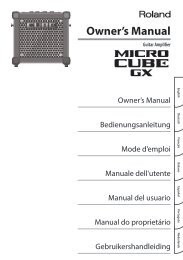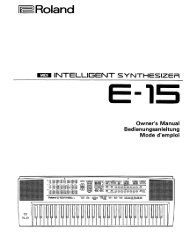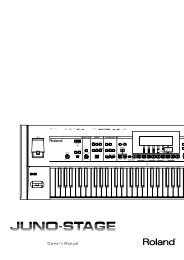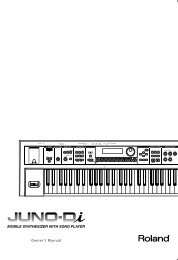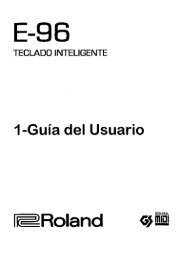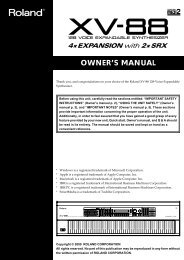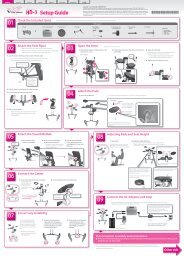Create successful ePaper yourself
Turn your PDF publications into a flip-book with our unique Google optimized e-Paper software.
Chapter 8. System Settings and MIDI Applications<br />
Synchronization with an External<br />
MIDI Device<br />
Timing of the D2’s sequencer can be synchronized with that<br />
of another sequencer for playback. This feature enables largescale<br />
performance playing back a number of parts at the<br />
same time.<br />
Making an external MIDI sequencer<br />
synchronized with playback on the D2<br />
Now, let’s make D2’s patterns synchronized with an external<br />
MIDI sequencer. (In this example, the external MIDI sound<br />
generator is played back using the MIDI data from the<br />
external MIDI sequencer.)<br />
Set up the D2<br />
1. Set SYNC OUT to “ON” (p. 74).<br />
This setting enables synchronizing signals to be<br />
transmitted from the D2’s MIDI OUT.<br />
2. Set the sequence output assignment for all parts of<br />
the pattern to be used to “INT” (p. 19).<br />
This setting enables the D2 to output only MIDI clocks<br />
and start/stop information from the MIDI OUT<br />
connector.<br />
Set up the external sequencer<br />
3. Set the external MIDI sequencer so it will<br />
synchronize to the MIDI Clock messages that it<br />
receives.<br />
For details on the setting, refer to the owner’s manual for<br />
your MIDI sequencer.<br />
Start synchronized playback.<br />
4. Press the [ ] button of the D2, and synchronized<br />
playback will begin.<br />
5. To stop synchronized playback, press [<br />
on the D2.<br />
The external MIDI sequencer will also stop.<br />
] button<br />
80<br />
MIDI IN MIDI OUT<br />
Sequencer<br />
D2<br />
Making the D2 synchronized with<br />
performance on an external<br />
sequencer.<br />
The playback of the D2’s sequencer can be synchronized to<br />
the MIDI Clock messages transmitted from an external MIDI<br />
sequencer or from a hard disk recorder (optional). In the<br />
following example, we will synchronize the D2 pattern<br />
playback to an external source of timing.<br />
MIDI OUT<br />
Set up the D2.<br />
MIDI IN<br />
Sequencer D2<br />
1. Set SYNC MODE to “SLAVE” (p. 74).<br />
2. Press the [ ] button on the D2.<br />
Returns to the beginning of pattern.<br />
Set up the external sequencer.<br />
3. Set up so that MIDI clocks are transmitted from the<br />
external MIDI sequencer.<br />
For details on the setting, refer to the owner’s manual for<br />
your external MIDI sequencer.<br />
Start synchronized playback.<br />
4. Press the [PLAY] button of the external MIDI<br />
sequencer, and synchronized playback will begin.<br />
5. To stop synchronized playback, press [STOP] button<br />
on the external sequencer.<br />
* As required, set up to block transmission of playback<br />
information from the external device to the D2. (Or, set MIDI<br />
channels 1 to 7 and 10, corresponding to those used on the D2,<br />
not to be used for data transmission.) Otherwise, the D2<br />
performs playback with playback information from the external<br />
device. For details, see the operation manual of the external<br />
MIDI device.<br />
* It is also possible to control playback/stop operations only<br />
without synchronization with MIDI clocks transmitted from<br />
the external MIDI sequencer. In this case, set Sync mode of the<br />
D2 to “REMOTE.”



